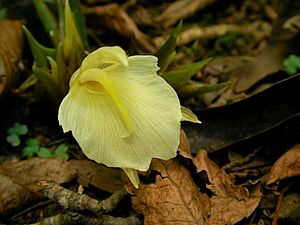Myoga facts for kids
Quick facts for kids Myōga |
|
|---|---|
 |
|
| Scientific classification | |
| Genus: |
Zingiber
|
| Species: |
mioga
|
| Synonyms | |
|
|
Myoga, also known as myoga ginger or Japanese ginger, is a special plant from the ginger family. Its scientific name is Zingiber mioga. It is a type of plant that grows back every year.
Myoga is originally from Japan, China, and the southern part of Korea. People mostly use its tasty flower buds and young shoots in cooking.
Contents
Cooking with Myoga
In Japanese cuisine, the flower buds are often cut into thin slices. They are used to add flavor to dishes like miso soup and sunomono (a type of vinegar salad). They also taste great with roasted eggplant.
In Korean cuisine, the flower buds are sometimes put on skewers with pieces of meat. Then, they are cooked in a pan until they are ready to eat.
Growing Myoga
Myoga has been grown in Japan for a very long time. Now, it is also grown in Australia and New Zealand. This helps supply myoga to the Japanese market.
Where Myoga Grows Best
Myoga is a woodland plant. This means it needs shady places to grow well. It can handle cold weather, even temperatures as low as -16 degrees Celsius (3 degrees Fahrenheit). It might even survive colder temperatures.
Different Types of Myoga
There are a few special types of myoga plants. These types have leaves with different colors or patterns. They are called 'Dancing Crane', 'Silver Arrow', and 'White Feather'. These colorful types are not as good at handling cold weather as the regular myoga plants.
Myoga and Health
Scientists are studying some parts of myoga. They are looking into how these parts might be helpful for health.
Gallery
See also
 In Spanish: Myoga para niños
In Spanish: Myoga para niños





